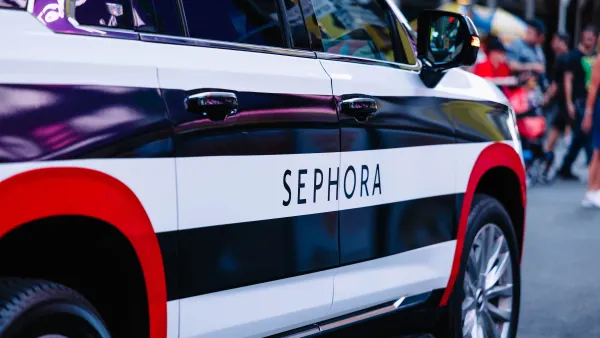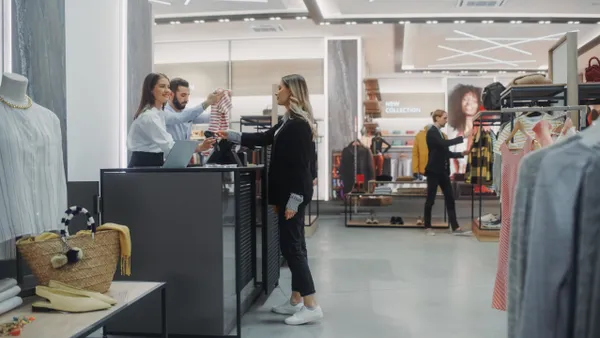Retail marketing is not a black-and-white, linear process. A consistent brand personality or story is likely on every retailer's wish list, but marketing tactics and methods vary greatly. Some retailers rely on discounts, sales and avoiding politics to drive traffic, while others feel comfortable being playful or taking a stand on social issues to win over loyal customers.
We've already taken a look back at the stories that impacted retail marketing in 2018, but those trends also tell us a lot about what to expect in the year to come. Here's our list of trends that could continue to shape retail marketing in 2019.
-
Retailers will be bolder with ad campaigns
Marketing isn't just about discounts, and ad campaigns shouldn't be either. Last year was a memorable one for retailers turning bold ideas into hit ad campaigns. One of the more talked about marketing moments of the year was Nike's decision to put Colin Kaepernick on its "Just Do It" roster in September. The company's ad with the controversial athlete elicited reactions from fans and dissenters alike, thanks to its focus on Kaepernick's protests against police brutality.
Bold campaigns won't just focus on controversy. One big trend in retail advertising is the shift toward inclusive marketing, which has led to many campaigns that likely wouldn't have existed a few years ago. Gap cast a diverse group of celebrities for an ad campaign in August, which featured Chella Man, a Chinese, transgender, queer, deaf, and Jewish artist and advocate, among others. Ikea Canada also got a lot of attention for an ad featuring drag queens and Bonobos was largely praised by customers for an ad urging them to #EvolvetheDefinition of masculinity, a trend that's cropping up more broadly as well.
That trend will likely continue in 2019, Corey Pierson, co-founder and CEO of Custora, told Retail Dive in an interview, but it won't make sense for all retailers to jump on board with bolder ad campaigns. Niche, direct-to-consumer brands are likely to be the ones carrying the trend through the new year.
"They are able to take some risks that perhaps the flagship department store brands that are serving the entire population of America can't get behind," he said. "Those smaller, more upstart brands — they're catering to a segment of the population where they have the ability to be more bold. Any area where a large chunk of their shoppers are in their 20s and 30s, that's where you're going to see that."
-
Loyalty gets an update
Loyalty programs are no longer just about spending $100 and getting 10 points toward an unclear rewards system. Retailers are updating old systems, replacing them and incorporating them into stores in new ways, and it's likely the industry will see more of that in the year to come.
Retailers that made big changes to loyalty programs in the past year included: Macy's, which left the Plenti program and introduced a new one that allows customers without a store card to use it; Target, which pulled a similar move in March for a pilot loyalty program; Kohl's, which combined its three loyalty programs into one centered around Kohl's Cash; J. Crew, which launched a card-free program; and Nordstrom, which unveiled The Nordy Club, paving the way for non-card holding members to participate.
Many of the changes appeared to finally bring loyalty programs up to customer's expectations, a potentially difficult feat when beauty retailers like Sephora and Ulta have set a high bar (and keep upgrading their own programs to raise it higher). But retailers in just about every space have taken 2018 to reexamine (and update) their loyalty programs — Sally Beauty upped perks in October, DSW launched a new program in May, which is already paying dividends for the shoe retailer, Wayfair introduced a membership-based loyalty program and Lululemon in its most recent quarter announced an extended pilot for a membership program that will cost participants more than $128 a year.
The types of rewards loyalty members receive are also rapidly changing. Innovations like Sephora's members-only social platform and Nike Live, the athletics retailer's members-only store concept, are giving shoppers more reason to join, and offer arguably more compelling benefits than the usual rewards points. Ray Hartjen, director of marketing and corporate communications at RetailNext, said personalization and value will be important when it comes to loyalty program updates in the coming year.
"A good example is Starbucks, whose loyalty program allows for a personalized experience that eliminates the need to wait to order and wait to pick up," Hartjen told Retail Dive in an email, emphasizing that this eliminates a friction point for shoppers. "Why would a regular customer not want to be part of the program? Moreover, why would a customer of a competitor without such an advantage not want to switch and become a program member?"
-
Social issues and politics duke it out in the marketing ring
Driven by consumer demands, retail is inching toward a future where companies stand up for causes that matter to their customer base — and marketing efforts have started to reflect that. Dick's Sporting Goods made waves in February when it announced it wouldn't be selling assault-style rifles at its Field & Stream stores anymore in the wake of the shooting at a Parkland, Florida high school. The company also went a step further, calling on lawmakers to ban assault-style firearms, high capacity magazines and bump stocks, raise the minimum age for purchasing firearms to 21 and require universal background checks.
The response was mixed, and controversial, but many studies found Dick's benefited from the move in a climate where customers are more and more interested in brands standing up for what they believe in. Patagonia has been arguably even more vocal about its values, using its first ever TV ad in 2017 to push back against the Trump administration, and launching other initiatives dedicated to grassroots environmentalist causes. The retailer was also part of a group of brands pushing customers to "Vote Every Day" by shopping their values — and politics — with which brands they spend money at.
Political and social-oriented advertising has become a huge trend for marketers as a whole, from Secret running an equal pay ad in November to SodaStream calling out the damage of plastic pollution in the ocean, and retailers are jumping aboard that trend more and more. We can expect more retailers to bring political and social issues into their advertising in the coming year, Pierson said, especially with the 2020 elections coming up.
"Maybe a couple of generations back, a retailer would never speak about something political. For a millennial, it's not that unusual," he said, noting that the proximity of the next elections will make it somewhat unavoidable. "I think it's going to be front-and-center and brands are going to have to be very intentional with which issues they do attach to."
-
Branding continues to be an issue
Branding is a slippery slope — and one that many retailers suffered from in the past year. Victoria's Secret struggled with an image rooted in its fashion show that no longer seems to resonate the way it once did. The retailer lost two top executives late in 2018, including CEO Jan Singer in November, and is facing competition from younger brands with more inclusive, playful messaging, and a more casual and comfortable approach to lingerie, including AdoreMe and ThirdLove.
Aerie saw success from a marketing platform based on body-positive influencers and authentic campaigns with slogans like, "Aerie Bras Make You Feel Real Good." The retailer's #AerieREAL campaign stands in stark contrast to Victoria's Secret's usual messaging, sporting models with diverse body types and skin tones, as well as some with disabilities or other medical conditions. Parent company American Eagle plans to expand the reach of its Aerie brand, and it continually buoys results for the company.
But Victoria's Secret isn't the only retail that's faced a disconnect with shoppers. Nike also received some flack this year for placing an emphasis on female shoppers in its branding at a time when its corporate culture was far from ideal. A lawsuit was filed against the retailer claiming an unequal workplace in August, just months after many top executives left the company. That has potential consequences, especially for a retailer trying to assert itself as a voice for many social issues, including Colin Kaepernick's place in its last "Just Do It" campaign.
"There were people who were going to be repeat customers and there were people who were burning their Nikes," Pierson said. "It has the potential to really generate that differentiator and build loyalty, but you're also playing with fire. The customers who supported Colin Kaepernick — those are the same customers who are going to be offended when they read about workplace issues."
-
Marketing on social gets more focused
Social media is a growing part of retail marketing. As young shoppers turn to social media not only to talk to each other, but also to interact with some of their favorite brands, retailers are getting more engaged on some of those platforms, encouraging shoppers to talk to them about everything from customer service questions to changes they'd like to see.
Outdoor Voices, for example, asks customers for their opinions on product development, and boasts that they talk to customers "like a best friend." Retailers are getting better at involving customers on social, and some, like Warby Parker, are also managing to encourage social interactions that pass on word-of-mouth about the brand and offer something to the customer as well, such as its at-home try-on service.
"'A unique thing about our business is this try-on, that we know speaks to our customers,'" Pierson said of how a company like Warby Parker uses social media for more of a purpose than just engagement. "'We know that one of the most compelling things is word-of-mouth, but we want them to be talking about our try-on experience. So how do we get them to talk about our try-on experience?'"
Social will also be an important way of building loyalty for retailers in the coming year, who need to focus on "two-way engagement" with shoppers, according to Hartjen.
"Programs will need to be an extension of where shoppers already are, and that's online, on social media platforms, where they can integrate user generated content like videos and reviews," he said. "Effective programs will be as much about listening as broadcasting, and they'll provide customers the opportunity to connect with the community as a whole, and not just a unidirectional interaction with the brand."












